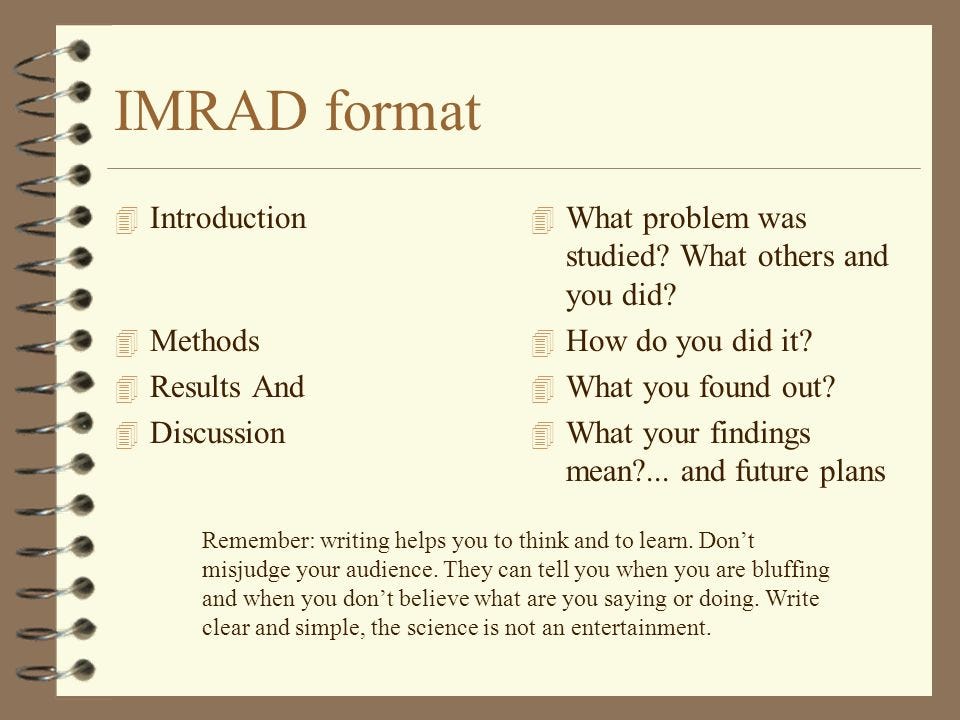
What is IMRaD?
A common scientific writing format is IMRAD, which stands for Introduction, Methods, Results, And Discussion. This type of scientific writing is useful for educating and recording knowledge about research processes as well as findings IMRD Cheat Sheet Abstract Abstracts can vary in length from one paragraph to several pages, but they follow the IMRaD format and typically spend: • 25% of their space on importance of research (Introduction) • 25% of their space on what you did (Methods) • 35% of their space on what you found: this is the most important part of the abstract (Results) • 15% of their space Abstract Background: The scientific article in the health sciences evolved from the letter form and purely descriptive style in the seventeenth century to a very standardized structure in the twentieth century known as introduction, methods, results, and discussion (IMRAD)

Recommended
Abstract Background: The scientific article in the health sciences evolved from the letter form and purely descriptive style in the seventeenth century to a very standardized structure in the twentieth century known as introduction, methods, results, and discussion (IMRAD) “IMRaD” format refers to a paper that is structured by four main sections: Introduction, Methods, Results, and Discussion. This format is often used for lab reports as well as for reporting any planned, systematic research in the social sciences, natural sciences, or engineering and computer sciences. Introduction – Make a case for your research A common scientific writing format is IMRAD, which stands for Introduction, Methods, Results, And Discussion. This type of scientific writing is useful for educating and recording knowledge about research processes as well as findings

Outline of Scholarly Writing
IMRD Cheat Sheet Abstract Abstracts can vary in length from one paragraph to several pages, but they follow the IMRaD format and typically spend: • 25% of their space on importance of research (Introduction) • 25% of their space on what you did (Methods) • 35% of their space on what you found: this is the most important part of the abstract (Results) • 15% of their space Abstract Background: The scientific article in the health sciences evolved from the letter form and purely descriptive style in the seventeenth century to a very standardized structure in the twentieth century known as introduction, methods, results, and discussion (IMRAD) A common scientific writing format is IMRAD, which stands for Introduction, Methods, Results, And Discussion. This type of scientific writing is useful for educating and recording knowledge about research processes as well as findings

Navigation menu
A common scientific writing format is IMRAD, which stands for Introduction, Methods, Results, And Discussion. This type of scientific writing is useful for educating and recording knowledge about research processes as well as findings Abstract Background: The scientific article in the health sciences evolved from the letter form and purely descriptive style in the seventeenth century to a very standardized structure in the twentieth century known as introduction, methods, results, and discussion (IMRAD) “IMRaD” format refers to a paper that is structured by four main sections: Introduction, Methods, Results, and Discussion. This format is often used for lab reports as well as for reporting any planned, systematic research in the social sciences, natural sciences, or engineering and computer sciences. Introduction – Make a case for your research

Writing in Different Genres
A common scientific writing format is IMRAD, which stands for Introduction, Methods, Results, And Discussion. This type of scientific writing is useful for educating and recording knowledge about research processes as well as findings Abstract Background: The scientific article in the health sciences evolved from the letter form and purely descriptive style in the seventeenth century to a very standardized structure in the twentieth century known as introduction, methods, results, and discussion (IMRAD) “IMRaD” format refers to a paper that is structured by four main sections: Introduction, Methods, Results, and Discussion. This format is often used for lab reports as well as for reporting any planned, systematic research in the social sciences, natural sciences, or engineering and computer sciences. Introduction – Make a case for your research
No comments:
Post a Comment